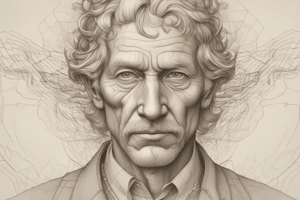Podcast
Questions and Answers
Which statement best reflects the concept of parsimony in theories?
Which statement best reflects the concept of parsimony in theories?
- Theories require extensive empirical evidence to be validated.
- Theories are better when they are simple and elegant. (correct)
- Theories are more effective when they incorporate many variables.
- Theories are better when they are complex and multifaceted.
What is the primary focus of evolutionary psychology?
What is the primary focus of evolutionary psychology?
- To understand psychological disorders through genetic factors.
- To study the biological basis of emotional responses.
- To explore how natural selection influences personality and behavior. (correct)
- To analyze the impact of social environment on mental health.
What does heritability measure in the context of personality traits?
What does heritability measure in the context of personality traits?
- The average similarity of traits between identical and fraternal twins.
- The proportion of variability related to genetic factors within a population. (correct)
- The extent to which a trait can be influenced by external factors.
- The overall stability of personality traits over a person's lifetime.
How is the heritability of traits typically estimated?
How is the heritability of traits typically estimated?
What percentage of variability in most traits is suggested to be heritable, based on the content?
What percentage of variability in most traits is suggested to be heritable, based on the content?
Which characteristic best describes temperament?
Which characteristic best describes temperament?
What are the four basic dimensions of temperament mentioned?
What are the four basic dimensions of temperament mentioned?
How is neuroticism generally understood in terms of genetic influence?
How is neuroticism generally understood in terms of genetic influence?
What developmental task is associated with infancy according to Erikson?
What developmental task is associated with infancy according to Erikson?
During which stage do individuals focus on planning and executing actions?
During which stage do individuals focus on planning and executing actions?
In which developmental stage do individuals primarily develop companionships and love relationships?
In which developmental stage do individuals primarily develop companionships and love relationships?
What is the primary focus during the Generativity vs. Stagnation stage?
What is the primary focus during the Generativity vs. Stagnation stage?
Which of the following stages involves evaluating one’s life for meaning and wisdom?
Which of the following stages involves evaluating one’s life for meaning and wisdom?
What criticism is often leveled at Erikson's Neo-Analytic Theory?
What criticism is often leveled at Erikson's Neo-Analytic Theory?
Which developmental stage directly follows Autonomy vs. Shame & Doubt?
Which developmental stage directly follows Autonomy vs. Shame & Doubt?
What is one advantage of Erikson's theory?
What is one advantage of Erikson's theory?
What characterizes extraverts according to Eysenck’s model?
What characterizes extraverts according to Eysenck’s model?
What is the main difference in CNS arousal between introverts and extraverts?
What is the main difference in CNS arousal between introverts and extraverts?
According to Gray’s Reinforcement Sensitivity Theory, what does an overactive Behavioral Activation System (BAS) lead to?
According to Gray’s Reinforcement Sensitivity Theory, what does an overactive Behavioral Activation System (BAS) lead to?
How do introverts respond to sensory stimuli compared to extraverts?
How do introverts respond to sensory stimuli compared to extraverts?
What psychological trait is associated with an overactive Behavioral Inhibition System (BIS)?
What psychological trait is associated with an overactive Behavioral Inhibition System (BIS)?
What kind of traits does Eysenck's model suggest introverts exhibit?
What kind of traits does Eysenck's model suggest introverts exhibit?
What effect does an overactive BAS have on a person’s behavior?
What effect does an overactive BAS have on a person’s behavior?
Which of the following best describes the concept of emotionality in temperament?
Which of the following best describes the concept of emotionality in temperament?
What is the primary focus of behaviorism as founded by John Watson?
What is the primary focus of behaviorism as founded by John Watson?
In Watson's 'Little Albert' experiment, what was the unconditional stimulus (UCS)?
In Watson's 'Little Albert' experiment, what was the unconditional stimulus (UCS)?
What does a reinforcer do in operant conditioning?
What does a reinforcer do in operant conditioning?
Which of the following is an example of negative reinforcement?
Which of the following is an example of negative reinforcement?
What pattern is described by Skinner's Law of Effect?
What pattern is described by Skinner's Law of Effect?
What is the effect of positive punishment?
What is the effect of positive punishment?
What term is used for a conditioned stimulus (CS) after conditioning has occurred?
What term is used for a conditioned stimulus (CS) after conditioning has occurred?
Which of the following is NOT a characteristic of operant conditioning?
Which of the following is NOT a characteristic of operant conditioning?
What is the role of the unconditioned stimulus (UCS) in classical conditioning?
What is the role of the unconditioned stimulus (UCS) in classical conditioning?
What occurs during the process of stimulus generalization?
What occurs during the process of stimulus generalization?
Which sequence accurately describes classical conditioning?
Which sequence accurately describes classical conditioning?
When does extinction occur in classical conditioning?
When does extinction occur in classical conditioning?
Which component is the conditioned stimulus (CS) after classical conditioning?
Which component is the conditioned stimulus (CS) after classical conditioning?
What happens during stimulus discrimination?
What happens during stimulus discrimination?
In Pavlov's experiment, what was the initially neutral stimulus?
In Pavlov's experiment, what was the initially neutral stimulus?
How does classical conditioning relate to fear responses, such as a child's fear of flying insects after being stung by bees?
How does classical conditioning relate to fear responses, such as a child's fear of flying insects after being stung by bees?
Flashcards are hidden until you start studying
Study Notes
Erik Erikson's Stages of Psychosocial Development
- Erikson proposed eight stages of psychosocial development, each characterized by a developmental task or crisis.
- Trust vs. Mistrust (infancy): The infant learns to trust their caregivers and their ability to meet their needs.
- Autonomy vs. Shame & Doubt (early childhood): The child develops a sense of independence and self-control, mastering basic skills and navigating social interactions.
- Initiative vs. Guilt (early to mid-childhood): The child gains confidence in their ability to take action and make decisions, learning to get along with others and develop a sense of responsibility.
- Industry vs. Inferiority (mid- to late childhood): The child learns to take pride in their accomplishments and discovers their talents.
- Identity vs. Role Confusion (adolescence): The adolescent develops a sense of self and their unique place in the world, exploring different roles and ultimately forming a cohesive identity.
- Intimacy vs. Isolation (early adulthood): The young adult develops the ability to form deep, meaningful relationships and establish a sense of belonging.
- Generativity vs. Stagnation (mid-adulthood): The adult contributes to society and gives back to the community, raising families and contributing to the next generation.
- Ego Integrity vs. Despair (late adulthood): The older adult reflects on their life and achieves acceptance of their accomplishments and failures, finding meaning and satisfaction in their life journey.
Criticism of Neo-Analytic Theory
- Advantages:
- Focuses on the "self" as the core aspect of personality, responsible for managing emotions, drives, and social demands.
- Recognizes the impact of social interactions, culture, and society on personality development.
- Emphasizes that personality development continues throughout life.
- Disadvantages:
- Lack of scientific rigor and empirical testing.
- Relies on abstract concepts that are difficult to observe or measure.
- Theory lacks parsimony; it is complex and incorporates many different ideas.
Biological Aspects of Personality
- Evolutionary Psychology posits that natural selection has favored certain traits influencing personality and social behavior. These traits enhance reproductive success and survival.
- Heritability refers to the proportion of trait variability within a population that is attributed to genetic factors. It is typically estimated through twin and family studies. Most personality traits exhibit substantial heritable components.
- Temperament refers to stable individual differences in emotional reactivity. These differences arise from variations in nervous system responses to environmental stimuli. Four dimensions of temperament:
- Activity: Active vs. passive
- Emotionality: Easily aroused vs. emotionally steady
- Sociability: Approachable vs. withdrawn
- Aggression/Impulsivity: Aggressive vs. conscientious.
Eysenck's Central Nervous System (CNS) Model of Temperament
-
Eysenck proposed that individual differences in CNS arousal explain introversion-extraversion.
- Introverts have higher CNS arousal, thus seeking less stimulation.
- Extraverts have lower CNS arousal, thus seeking more stimulation.
-
Evidence of this comes from studies on:
- Electrodermal activity (GSR): Extroverts show less arousal on skin conductance.
- Electroencephalography (EEG): Extroverts show less CNS arousal.
- Habituation to Sensory Stimuli: Introverts habituate slower to stimuli.
Gray's Reinforcement Sensitivity Theory
- Gray proposed two bio-learning systems that influence personality:
- Behavioral Activation System (BAS): Responds to rewards and pleasurable stimuli. An overactive BAS leads to impulsivity, reward-seeking, and sensation-seeking.
- Behavioral Inhibition System (BIS): Orients the person to novel and threatening situations. An overactive BIS leads to anxiety, alertness, and worrying.
Classical Conditioning
- Proposed by Ivan Pavlov.
- Key Concepts:
- Neutral Stimulus (NS): Does not elicit a response.
- Unconditioned Stimulus (UCS): Naturally elicits a response.
- Unconditioned Response (UCR): The natural response to UCS.
- Conditioned Stimulus (CS): Formerly a NS, but now elicits a response after pairing with UCS.
- Conditioned Response (CR): Formerly a UCR, but now elicited by a CS.
- Stimulus Generalization: Occurs when CR is elicited by stimuli similar to CS.
- Stimulus Discrimination: Learning to differentiate between CS and similar stimuli.
- Extinction: The CS loses its power to elicit CR if repeatedly presented without UCS.
Origins of Behaviorism
- John Watson (1920s) rejected introspection and founded behaviorism, focusing on the scientific study of observable behavior.
- The "Little Albert" experiment demonstrated conditioned fear responses in a child. A neutral stimulus (white rat) was paired with a loud noise (UCS) and the child (Albert) developed a fear of the white rat alone (CR).
Radical Behaviorism
- B.F. Skinner (1940s-1960s), influenced by Edward Thorndike's "Law of effect," proposed operant conditioning.
- Operant conditioning explains how consequences influence behavior:
- Reinforcer: Increases the probability of a behavior occurring.
- Punisher: Decreases the probability of a behavior occurring.
- Types of Reinforcement:
- Positive Reinforcement: Adding a pleasant stimulus.
- Negative Reinforcement: Removing an unpleasant stimulus.
- Types of Punishment:
- Positive Punishment: Adding an unpleasant stimulus.
- Negative Punishment: Removing a pleasant stimulus.
Studying That Suits You
Use AI to generate personalized quizzes and flashcards to suit your learning preferences.




